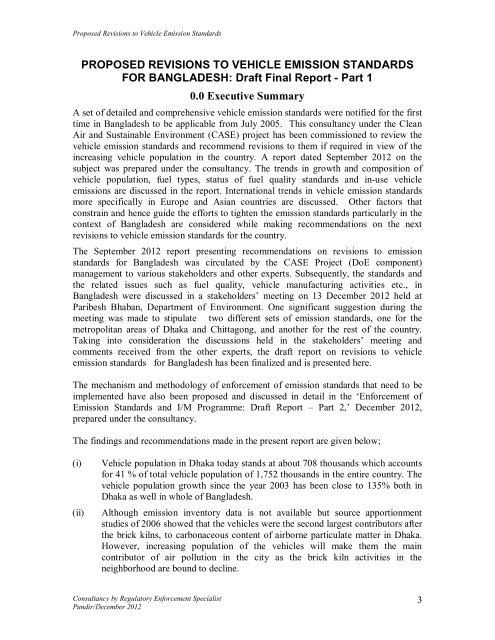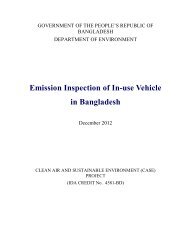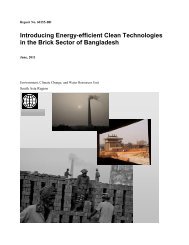Revisions of Vehicular Emission Standards for Bangladesh - CASE
Revisions of Vehicular Emission Standards for Bangladesh - CASE
Revisions of Vehicular Emission Standards for Bangladesh - CASE
You also want an ePaper? Increase the reach of your titles
YUMPU automatically turns print PDFs into web optimized ePapers that Google loves.
Proposed <strong>Revisions</strong> to Vehicle <strong>Emission</strong> <strong>Standards</strong><br />
PROPOSED REVISIONS TO VEHICLE EMISSION STANDARDS<br />
FOR BANGLADESH: Draft Final Report - Part 1<br />
0.0 Executive Summary<br />
A set <strong>of</strong> detailed and comprehensive vehicle emission standards were notified <strong>for</strong> the first<br />
time in <strong>Bangladesh</strong> to be applicable from July 2005. This consultancy under the Clean<br />
Air and Sustainable Environment (<strong>CASE</strong>) project has been commissioned to review the<br />
vehicle emission standards and recommend revisions to them if required in view <strong>of</strong> the<br />
increasing vehicle population in the country. A report dated September 2012 on the<br />
subject was prepared under the consultancy. The trends in growth and composition <strong>of</strong><br />
vehicle population, fuel types, status <strong>of</strong> fuel quality standards and in-use vehicle<br />
emissions are discussed in the report. International trends in vehicle emission standards<br />
more specifically in Europe and Asian countries are discussed. Other factors that<br />
constrain and hence guide the ef<strong>for</strong>ts to tighten the emission standards particularly in the<br />
context <strong>of</strong> <strong>Bangladesh</strong> are considered while making recommendations on the next<br />
revisions to vehicle emission standards <strong>for</strong> the country.<br />
The September 2012 report presenting recommendations on revisions to emission<br />
standards <strong>for</strong> <strong>Bangladesh</strong> was circulated by the <strong>CASE</strong> Project (DoE component)<br />
management to various stakeholders and other experts. Subsequently, the standards and<br />
the related issues such as fuel quality, vehicle manufacturing activities etc., in<br />
<strong>Bangladesh</strong> were discussed in a stakeholders’ meeting on 13 December 2012 held at<br />
Paribesh Bhaban, Department <strong>of</strong> Environment. One significant suggestion during the<br />
meeting was made to stipulate two different sets <strong>of</strong> emission standards, one <strong>for</strong> the<br />
metropolitan areas <strong>of</strong> Dhaka and Chittagong, and another <strong>for</strong> the rest <strong>of</strong> the country.<br />
Taking into consideration the discussions held in the stakeholders’ meeting and<br />
comments received from the other experts, the draft report on revisions to vehicle<br />
emission standards <strong>for</strong> <strong>Bangladesh</strong> has been finalized and is presented here.<br />
The mechanism and methodology <strong>of</strong> en<strong>for</strong>cement <strong>of</strong> emission standards that need to be<br />
implemented have also been proposed and discussed in detail in the ‘En<strong>for</strong>cement <strong>of</strong><br />
<strong>Emission</strong> <strong>Standards</strong> and I/M Programme: Draft Report – Part 2,’ December 2012,<br />
prepared under the consultancy.<br />
The findings and recommendations made in the present report are given below;<br />
(i)<br />
(ii)<br />
Vehicle population in Dhaka today stands at about 708 thousands which accounts<br />
<strong>for</strong> 41 % <strong>of</strong> total vehicle population <strong>of</strong> 1,752 thousands in the entire country. The<br />
vehicle population growth since the year 2003 has been close to 135% both in<br />
Dhaka as well in whole <strong>of</strong> <strong>Bangladesh</strong>.<br />
Although emission inventory data is not available but source apportionment<br />
studies <strong>of</strong> 2006 showed that the vehicles were the second largest contributors after<br />
the brick kilns, to carbonaceous content <strong>of</strong> airborne particulate matter in Dhaka.<br />
However, increasing population <strong>of</strong> the vehicles will make them the main<br />
contributor <strong>of</strong> air pollution in the city as the brick kiln activities in the<br />
neighborhood are bound to decline.<br />
Consultancy by Regulatory En<strong>for</strong>cement Specialist<br />
Pundir/December 2012<br />
3




